Clownfish
| Clownfish | |
|---|---|

| |
| Ocellaris clownfish (Amphiprion ocellaris) | |
| Scientific classification | |
| Domain: | Eukaryota |
| Kingdom: | Animalia |
| Phylum: | Chordata |
| Class: | Actinopterygii |
| Clade: | Ovalentaria |
| Order: | Blenniiformes |
| Family: | Pomacentridae |
| Subfamily: | Amphiprioninae Allen, 1975 |
| Genera | |
| |
Clownfish or anemonefish are fishes from the subfamily Amphiprioninae in the family Pomacentridae. Thirty species of clownfish are recognized: one in the genus Premnas, while the remaining are in the genus Amphiprion. In the wild, they all form symbiotic mutualisms with sea anemones. Depending on the species, anemonefish are overall yellow, orange, or a reddish or blackish color, and many show white bars or patches. The largest can reach a length of 17 cm (6+1⁄2 in), while the smallest barely achieve 7–8 cm (2+3⁄4–3+1⁄4 in).
Distribution and habitat
[edit]Anemonefish are endemic to the warmer waters of the Indian Ocean, including the Red Sea, and Pacific Ocean, the Great Barrier Reef, Hawaii, USA, North America, Southeast Asia, Japan, and the Indo-Malaysian region. While most species have restricted distributions, others are widespread. Anemonefish typically live at the bottom of shallow seas in sheltered reefs or in shallow lagoons. No anemonefish are found in the Atlantic.[1]
Diet
[edit]
Anemonefish are omnivorous and can feed on undigested food from their host anemones, and the fecal matter from the anemonefish provides nutrients to the sea anemone. Anemonefish primarily feed on small zooplankton from the water column, such as copepods and tunicate larvae, with a small portion of their diet coming from algae, with the exception of Amphiprion perideraion, which primarily feeds on algae.[2][3]
Symbiosis and mutualism
[edit]Anemonefish and sea anemones have a symbiotic, mutualistic relationship, each providing many benefits to the other. The individual species are generally highly host specific. The sea anemone protects the anemonefish from predators, as well as providing food through the scraps left from the anemone's meals and occasional dead anemone tentacles, and functions as a safe nest site. In return, the anemonefish defends the anemone from its predators and parasites.[4][5] The anemone also picks up nutrients from the anemonefish's excrement.[6] The nitrogen excreted from anemonefish increases the number of algae incorporated into the tissue of their hosts, which aids the anemone in tissue growth and regeneration.[3] The activity of the anemonefish results in greater water circulation around the sea anemone,[7] and it has been suggested that their bright coloring might lure small fish to the anemone, which then catches them.[8] Studies on anemonefish have found that they alter the flow of water around sea anemone tentacles by certain behaviors and movements such as "wedging" and "switching". Aeration of the host anemone tentacles allows for benefits to the metabolism of both partners, mainly by increasing anemone body size and both anemonefish and anemone respiration.[9]
Bleaching of the host anemone can occur when warm temperatures cause a reduction in algal symbionts within the anemone. Bleaching of the host can cause a short-term increase in the metabolic rate of resident anemonefish, probably as a result of acute stress.[10] Over time, however, there appears to be a down-regulation of metabolism and a reduced growth rate for fish associated with bleached anemones. These effects may stem from reduced food availability (e.g. anemone waste products, symbiotic algae) for the anemonefish.[11]
Several theories are given about how they can survive the sea anemone venom:
- The mucus coating of the fish may be based on sugars rather than proteins. This would mean that anemones fail to recognize the fish as a potential food source and do not fire their nematocysts, or sting organelles.
- The coevolution of certain species of anemonefish with specific anemone host species may have allowed the fish to evolve an immunity to the nematocysts and toxins of their hosts. Amphiprion percula may develop resistance to the toxin from Heteractis magnifica, but it is not totally protected since it was shown experimentally to die when its skin, devoid of mucus, was exposed to the nematocysts of its host.[12]
Anemonefish are the best known example of fish that are able to live among the venomous sea anemone tentacles, but several others occur, including juvenile threespot dascyllus, certain cardinalfish (such as Banggai cardinalfish), incognito (or anemone) goby, and juvenile painted greenling.[13][14][15]
Reproduction
[edit]
In a group of anemonefish, a strict dominance hierarchy exists. The largest and most aggressive female is found at the top. Only two anemonefish, a male and a female, in a group reproduce – through external fertilization. Anemonefish are protandrous sequential hermaphrodites, meaning they develop into males first, and when they mature, they become females. If the female anemonefish is removed from the group, such as by death, one of the largest and most dominant males becomes a female.[16] The remaining males move up a rank in the hierarchy. Clownfish live in a hierarchy, like hyenas, except smaller and based on size not sex, and order of joining/birth.[citation needed]
Anemonefish lay eggs on any flat surface close to their host anemones. In the wild, anemonefish spawn around the time of the full moon. Depending on the species, they can lay hundreds or thousands of eggs. The male parent guards the eggs until they hatch about 6–10 days later, typically two hours after dusk.[17]
Parental investment
[edit]
Anemonefish colonies usually consist of the reproductive male and female and a few male juveniles, which help tend the colony.[18] Although multiple males cohabit an environment with a single female, polygamy does not occur and only the adult pair exhibits reproductive behavior. However, if the female dies, the social hierarchy shifts with the breeding male exhibiting protandrous sex reversal to become the breeding female. The largest juvenile then becomes the new breeding male after a period of rapid growth.[19] The existence of protandry in anemonefish may rest on the case that nonbreeders modulate their phenotype in a way that causes breeders to tolerate them. This strategy prevents conflict by reducing competition between males for one female. For example, by purposefully modifying their growth rate to remain small and submissive, the juveniles in a colony present no threat to the fitness of the adult male, thereby protecting themselves from being evicted by the dominant fish.[20]
The reproductive cycle of anemonefish is often correlated with the lunar cycle. Rates of spawning for anemonefish peak around the first and third quarters of the moon. The timing of this spawn means that the eggs hatch around the full moon or new moon periods. One explanation for this lunar clock is that spring tides produce the highest tides during full or new moons. Nocturnal hatching during high tide may reduce predation by allowing for a greater capacity for escape. Namely, the stronger currents and greater water volume during high tide protect the hatchlings by effectively sweeping them to safety. Before spawning, anemonefish exhibit increased rates of anemone and substrate biting, which help prepare and clean the nest for the spawn.[19]
Before making the clutch, the parents often clear an oval-shaped clutch varying in diameter for the spawn. Fecundity, or reproductive rate, of the females, usually ranges from 600 to 1,500 eggs depending on her size. In contrast to most animal species, the female only occasionally takes responsibility for the eggs, with males expending most of the time and effort. Male anemonefish care for their eggs by fanning and guarding them for 6 to 10 days until they hatch. In general, eggs develop more rapidly in a clutch when males fan properly, and fanning represents a crucial mechanism for successfully developing eggs. This suggests that males can control the success of hatching an egg clutch by investing different amounts of time and energy toward the eggs. For example, a male could choose to fan less in times of scarcity or fan more in times of abundance. Furthermore, males display increased alertness when guarding more valuable broods, or eggs in which paternity is guaranteed. Females, though, display generally less preference for parental behavior than males. All these suggest that males have increased parental investment towards eggs compared to females.[21]
Clownfish hatchlings undergo development after hatching in regards to both their body size and fins. If maintained at the demanded thermal regulation, clownfish undergo proper development of their fins. Clownfish follow the ensuing order in their fin development "Pectorals < caudal < dorsal = anal < pelvic". The early larval stage is crucial to ensure a healthy progression of growth.[22]
Taxonomy
[edit]Historically, anemonefish have been identified by morphological features and color pattern in the field, while in a laboratory, other features such as scalation of the head, tooth shape, and body proportions are used.[2] These features have been used to group species into six complexes: percula, tomato, skunk, clarkii, saddleback, and maroon.[23] As can be seen from the gallery, each of the fish in these complexes has a similar appearance. Genetic analysis has shown that these complexes are not monophyletic groups, particularly the 11 species in the A. clarkii group, where only A. clarkii and A. tricintus are in the same clade, with six species,A . allardi A. bicinctus, A. chagosensis, A. chrosgaster, A. fuscocaudatus, A. latifasciatus, and A. omanensis being in an Indian clade, A. chrysopterus having monospecific lineage, and A. akindynos in the Australian clade with A. mccullochi.[24] Other significant differences are that A. latezonatus also has monospecific lineage, and A. nigripes is in the Indian clade rather than with A. akallopisos, the skunk anemonefish.[25] A. latezonatus is more closely related to A. percula and Premnas biaculeatus than to the saddleback fish with which it was previously grouped.[26][25]
Obligate mutualism was thought to be the key innovation that allowed anemonefish to radiate rapidly, with rapid and convergent morphological changes correlated with the ecological niches offered by the host anemones.[26] The complexity of mitochondrial DNA structure shown by genetic analysis of the Australian clade suggested evolutionary connectivity among samples of A. akindynos and A. mccullochi that the authors theorize was the result of historical hybridization and introgression in the evolutionary past. The two evolutionary groups had individuals of both species detected, thus the species lacked reciprocal monophyly. No shared haplotypes were found between species.[27]
Phylogenetic relationships
[edit]| Scientific name | Common name | Clade [24] | Complex | image |
|---|---|---|---|---|
| Genus Amphiprion:[28] | ||||
| Amphiprion akallopisos | Skunk anemonefish | A. akallopisos | Skunk | 
|
| A. akindynos | Australian | A. clarkii | 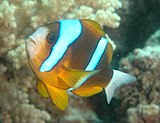
| |
| A. allardi | Allard's anemonefish | Indian | A. clarkii | 
|
| A. barberi | Barber's anemonefish | A. ephippium | A. ephippium | 
|
| A. bicinctus | Two-band anemonefish | Indian | A. clarkii | 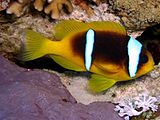
|
| A. chagosensis | Chagos anemonefish | Indian | A. clarkii | 
|
| A. chrysogaster | Mauritian anemonefish | Indian | A. clarkii | 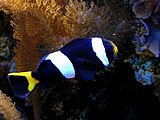
|
| A. chrysopterus | Orange-fin anemonefish | Monospecific lineage | A. clarkii | 
|
| A. clarkii | Clark's anemonefish | A. clarkii | A. clarkii | 
|
| A. ephippium | Red saddleback anemonefish | A. ephippium | A. ephippium | 
|
| A. frenatus | Tomato anemonefish | A. ephippium | A. ephippium | 
|
| A. fuscocaudatus | Seychelles anemonefish | Indian [n 1] | A. clarkii | 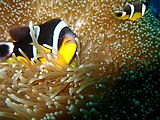
|
| A. latezonatus | Wide-band anemonefish | Monospecific lineage | Saddleback | 
|
| A. latifasciatus | Madagascar anemonefish | Indian | A. clarkii | 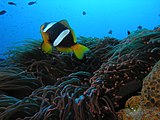
|
| A. leucokranos | White-bonnet anemonefish | Likely hybrid | Skunk | 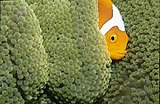
|
| A. mccullochi | Whitesnout anemonefish | Australian | A. ephippium | 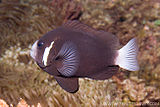
|
| A. melanopus | Red and black anemonefish | A. ephippium | A. ephippium | 
|
| A. nigripes | Maldive anemonefish | Indian | Skunk | 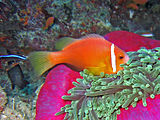
|
| A. ocellaris | False clown anemonefish | Percula | Clownfish | 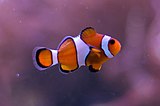
|
| A. ocellaris | Black Storm Clownfish | Percula | Clownfish | 
|
| A. ocellaris | Orange Storm Clownfish | Percula | Clownfish | 
|
| A. omanensis | Oman anemonefish | Indian | A. clarkii | 
|
| A. pacificus | Pacific anemonefish | A. akallopisos | Skunk | |
| A. percula | Clown anemonefish | Percula | Clownfish | 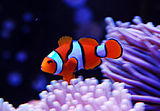
|
| A. perideraion | Pink skunk anemonefish | A. akallopisos | Skunk | 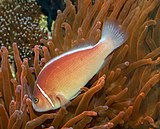
|
| A. polymnus | Saddleback anemonefish | A. polymnus | Saddleback | 
|
| A. rubrocinctus | Australian anemonefish | A. ephippium | A. ephippium | 
|
| A. sandaracinos | Orange anemonefish | A. akallopisos | Skunk | 
|
| A. sebae | Sebae anemonefish | A. polymnus | Saddleback | 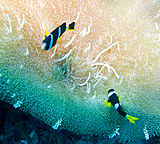
|
| A. thiellei | Thielle's anemonefish | Likely hybrid | Skunk | |
| A. tricinctus | Three-band anemonefish | Clarkii | Clarkii | 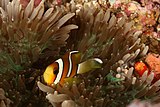
|
| Genus Premnas:[29] | ||||
| Premnas biaculeatus | Maroon anemonefish | Percula | Maroon | 
|
Morphological diversity by complex
[edit]-
A. percula (clown anemonefish) in a 'normal' orange and a melanistic blackish variant
-
A. clarkii (Clark's anemonefish)
-
A. ephippium (red saddleback anemonefish)
-
A. perideraion (pink skunk anemonefish)
-
Male P. biaculeatus (maroon anemonefish) in Papua New Guinea
In the aquarium
[edit]Anemonefish make up approximately 43% of the global marine ornamental trade, and approximately 25% of the global trade comes from fish bred in captivity, while the majority is captured from the wild,[30][31] accounting for decreased densities in exploited areas.[32] Public aquaria and captive-breeding programs are essential to sustain their trade as marine ornamentals, and has recently become economically feasible.[33][34] It is one of a handful of marine ornamentals whose complete lifecycle has been in closed captivity. Members of some anemonefish species, such as the maroon clownfish, become aggressive in captivity; others, like the false percula clownfish, can be kept successfully with other individuals of the same species.[35]
When a sea anemone is not available in an aquarium, the anemonefish may settle in some varieties of soft corals, or large polyp stony corals.[36] Once an anemone or coral has been adopted, the anemonefish will defend it. Anemonefish, however, are not obligately tied to hosts, and can survive alone in captivity.[37][38]
Clownfish sold from captivity make up a very small account (10%) of the total trade of these fishes. Designer Clownfish, scientifically named A. ocellaris are much costlier and obtaining them has disrupted their coral reefs. Their attractive allure, color, and patterning have made them out to be an attractive target in wild trading.[22]
In popular culture
[edit]
In Disney Pixar's 2003 film Finding Nemo and its 2016 sequel Finding Dory main characters Nemo, his father Marlin, and his mother Coral are clownfish from the species A. ocellaris.[39] The popularity of anemonefish for aquaria increased following the film's release; it is the first film associated with an increase in the numbers of those captured in the wild.[40]
Notes
[edit]References
[edit]- ^ Society, National Geographic (10 May 2011). "Clown Anemonefish, Clown Anemonefish Pictures, Clown Anemonefish Facts – National Geographic". Archived from the original on 13 January 2010.
- ^ a b Fautin, Daphne G.; Allen, Gerald R. (1997). Field Guide to Anemone Fishes and Their Host Sea Anemones. Western Australian Museum. ISBN 9780730983651. Archived from the original on 14 April 2015.
- ^ a b Porat, D.; Chadwick-Furman, N.E. (March 2005). "Effects of anemonefish on giant sea anemones: Ammonium uptake, zooxanthella content and tissue regeneration". Marine and Freshwater Behaviour and Physiology. 38 (1): 43–51. Bibcode:2005MFBP...38...43P. doi:10.1080/10236240500057929. S2CID 53051081.
- ^ "Clown Anemonefish". Nat Geo Wild: Animals. National Geographic Society. 10 May 2011. Archived from the original on 13 January 2010. Retrieved 19 December 2011.
- ^ "Clownfish". The Encyclopedia of Life.
- ^ Holbrook, S. J. and Schmitt, R. J. Growth, reproduction and survival of a tropical sea anemone (Actiniaria): benefits of hosting anemonefish, 2005, cited in blogspot.com
- ^ Szczebak, J. T.; Henry, R. P.; Al-Horani, F. A.; Chadwick, N. E. (15 March 2013). "Anemonefish oxygenate their anemone hosts at night". Journal of Experimental Biology. 216 (6): 970–976. doi:10.1242/jeb.075648. PMID 23447664.
- ^ "Clown Anemonefishes, Amphiprion ocellaris". Marinebio. The MarineBio Conservation Society. Archived from the original on 27 October 2011. Retrieved 19 December 2011.
- ^ Szczebak, J. T.; Henry, R. P.; Al-Horani, F. A.; Chadwick, N. E. (15 March 2013). "Anemonefish oxygenate their anemone hosts at night". Journal of Experimental Biology. 216 (6): 970–976. doi:10.1242/jeb.075648. PMID 23447664. S2CID 205352.
- ^ Norin, Tommy; Mills, Suzanne; Crespel, Amelie; Cortese, Daphne; Beldade, Ricardo; Killen, Shaun (2018). "Anemone bleaching increases the metabolic demands of symbiont anemonefish". Proceedings of the Royal Society B. 285 (1876). doi:10.1098/rspb.2018.0282. PMC 5904320. PMID 29643214.
- ^ Cortese, Daphne; Norin, Tommy; Beldade, Ricardo; Crespel, Amelie; Killen, Shaun; Mills, Suzanne (2021). "Physiological and behavioural effects of anemone bleaching on symbiont anemonefish in the wild". Functional Ecology. 35 (3): 663–674. Bibcode:2021FuEco..35..663C. doi:10.1111/1365-2435.13729.
- ^ Mebs, D. (September 1994). "Anemonefish symbiosis: Vulnerability and resistance of fish to the toxin of the sea anemone". Toxicon. 32 (9): 1059–1068. Bibcode:1994Txcn...32.1059M. doi:10.1016/0041-0101(94)90390-5. PMID 7801342.
- ^ Lieske, E.; and R. Myers (1999). Coral Reef Fishes. ISBN 0-691-00481-1
- ^ Patzner, R.A. (5 July 2017). "Gobius incognitus". Archived from the original on 7 August 2020. Retrieved 10 January 2018.
- ^ Fretwell, K.; and B. Starzomski (2014). Painted greenling. Biodiversity of the Central Coast. Retrieved 29 January 2015.
- ^ Buston, P. (2004). "Does the Presence of Non-Breeders Enhance the Fitness of Breeders? An Experimental Analysis in the Clown Anemonefish Amphiprion percula". Behavioral Ecology and Sociobiology. 57 (1): 23–31. Bibcode:2004BEcoS..57...23B. doi:10.1007/s00265-004-0833-2. S2CID 24516887.
- ^ Jeff Hesketh. "Clownfish breeding for beginners". Mad Hatter's Reef. Retrieved 19 October 2023.
- ^ Stephanie Boyer. "Clown Anemofish". Florida Museum of Natural History. Archived from the original on 28 October 2005. Retrieved 15 September 2013.
- ^ a b Ross, Robert M. (1978). "Reproductive Behavior of the Anemonefish Amphiprion melanopus on Guam". Copeia. 1978 (1): 103–107. doi:10.2307/1443829. JSTOR 1443829.
- ^ Buston, Peter (November 2004). "Does the presence of non-breeders enhance the fitness of breeders? An experimental analysis in the clown anemonefish Amphiprion percula". Behavioral Ecology and Sociobiology. 57 (1): 23–31. Bibcode:2004BEcoS..57...23B. doi:10.1007/s00265-004-0833-2. S2CID 24516887.
- ^ Ghosh, Swagat; Kumar, T. T. Ajith; Balasubramanian, T. (October 2012). "Determining the level of parental care relating fanning behavior of five species of clownfishes in captivity" (PDF). Indian Journal of Geo-Marine Sciences. 41 (5): 430–441.
- ^ a b Anikuttan Kuttan Kuravamparambu; Rameshkumar Palsamy; Nazar Abdul Khudus; et al. (2022). "Designer clown fishes: Unraveling the ambiguities". Frontiers in Marine Science. 9. doi:10.3389/fmars.2022.907362. ISSN 2296-7745.
- ^ Goemans, B. "Anemonefishes". Retrieved 20 September 2015.
- ^ a b c Litsios, Glenn; Salamin, Nicolas (December 2014). "Hybridisation and diversification in the adaptive radiation of clownfishes". BMC Evolutionary Biology. 14 (1): 245. Bibcode:2014BMCEE..14..245L. doi:10.1186/s12862-014-0245-5. PMC 4264551. PMID 25433367.
- ^ a b DeAngelis, R. "What we really know about the diversity of Clownfish". Archived from the original on 25 September 2015. Retrieved 20 September 2015.
- ^ a b Litsios, Glenn; Sims, Carrie A; Wüest, Rafael O; Pearman, Peter B; Zimmermann, Niklaus E; Salamin, Nicolas (2012). "Mutualism with sea anemones triggered the adaptive radiation of clownfishes". BMC Evolutionary Biology. 12 (1): 212. Bibcode:2012BMCEE..12..212L. doi:10.1186/1471-2148-12-212. PMC 3532366. PMID 23122007.
- ^ van der Meer, M. H.; Jones, G. P.; Hobbs, J.-P. A.; van Herwerden, L. (July 2012). "Historic hybridization and introgression between two iconic Australian anemonefish and contemporary patterns of population connectivity: Historic Hybridization between Anemonefish". Ecology and Evolution. 2 (7): 1592–1604. doi:10.1002/ece3.251. PMC 3434915. PMID 22957165.
- ^ Froese, Rainer; Pauly, Daniel (eds.). "Species in genus Amphiprion". FishBase. December 2011 version.
- ^ Froese, Rainer; Pauly, Daniel (eds.). "Species in genus Premnas". FishBase. December 2011 version.
- ^ Dhaneesh, K. V.; Vinoth, R.; Ghosh, Swagat; Gopi, M.; Kumar, T. T. Ajith; Balasubramanian, T. (2013). "Hatchery Production of Marine Ornamental Fishes: An Alternate Livelihood Option for the Island Community at Lakshadweep". Climate Change and Island and Coastal Vulnerability. pp. 253–265. doi:10.1007/978-94-007-6016-5_17. ISBN 978-94-007-6015-8.
- ^ Taylor, M.; Razak, T. & Green, E. (2003). From ocean to aquarium: A global trade in marine ornamental species (PDF). UNEP world conservation and monitoring centre (WCMC). pp. 1–64. Archived from the original (PDF) on 1 July 2004. Retrieved 18 April 2013.
- ^ Shuman, Craig S.; Hodgson, Gregor; Ambrose, Richard F. (December 2005). "Population impacts of collecting sea anemones and anemonefish for the marine aquarium trade in the Philippines". Coral Reefs. 24 (4): 564–573. Bibcode:2005CorRe..24..564S. doi:10.1007/s00338-005-0027-z. S2CID 25027153.
- ^ Watson, Craig A.; Hill, Jeffrey E. (May 2006). "Design criteria for recirculating, marine ornamental production systems". Aquacultural Engineering. 34 (3): 157–162. Bibcode:2006AqEng..34..157W. doi:10.1016/j.aquaeng.2005.07.002.
- ^ Hall, Heather; Douglas Warmolts (2003). "23". In James C. Cato; Christopher L. Brown (eds.). Marine Ornamental Species: Collection, Culture and Conservation. Wiley-Blackwell. pp. 303–326. ISBN 978-0-8138-2987-6.
- ^ Tullock, John (1998). Clownfish and Sea Anemones (illustrated ed.). Barron's Educational Series. pp. 11–22. ISBN 9780764105111. Retrieved 11 May 2015.
- ^ Fatherree, James W. "Aquarium Fish: On the Clownfishes' Range of Hosts". Advanced Aquarist. Archived from the original on 22 March 2014. Retrieved 31 December 2016.
- ^ Daphne Gail Fautin (1991). "The anemonefish symbiosis: what is known and what is not" (PDF). Symbiosis. 10: 23–46. Archived from the original (PDF) on 25 May 2012.
- ^ Ronald L. Shimek (2004). Marine Invertebrates. Neptune City, NJ: T.F.H. Publications. p. 83. ISBN 978-1-890087-66-1.
- ^ "Finding Nemo (2003)". Rotten Tomatoes. Retrieved 5 April 2016.
- ^ Calado, Ricardo; Olivotto, Ike; Oliver, Miquel Planas; Holt, G. Joan (6 March 2017). Marine Ornamental Species Aquaculture. John Wiley & Sons. p. 179. ISBN 9780470673904 – via Google Books.
Further reading
[edit]- Casas, Laura; Saborido-Rey, Fran; Ryu, Taewoo; Michell, Craig; Ravasi, Timothy; Irigoien, Xabier (17 October 2016). "Sex Change in Clownfish: Molecular Insights from Transcriptome Analysis". Scientific Reports. 6: 35461. Bibcode:2016NatSR...635461C. doi:10.1038/srep35461. ISSN 2045-2322. PMC 5066260. PMID 27748421.
- Roux, Natacha; Lami, Raphaël; Salis, Pauline; Magré, Kévin; Romans, Pascal; Masanet, Patrick; Lecchini, David; Laudet, Vincent (December 2019). "Sea anemone and clownfish microbiota diversity and variation during the initial steps of symbiosis". Scientific Reports. 9 (1): 19491. Bibcode:2019NatSR...919491R. doi:10.1038/s41598-019-55756-w. PMC 6925283. PMID 31862916.
- Vargas-Abúndez, Arturo Jorge; Randazzo, Basilio; Foddai, Marco; Sanchini, Lorenzo; Truzzi, Cristina; Giorgini, Elisabetta; Gasco, Laura; Olivotto, Ike (January 2019). "Insect meal based diets for clownfish: Biometric, histological, spectroscopic, biochemical and molecular implications". Aquaculture. 498: 1–11. Bibcode:2019Aquac.498....1V. doi:10.1016/j.aquaculture.2018.08.018. hdl:2318/1674109. S2CID 92357750.







